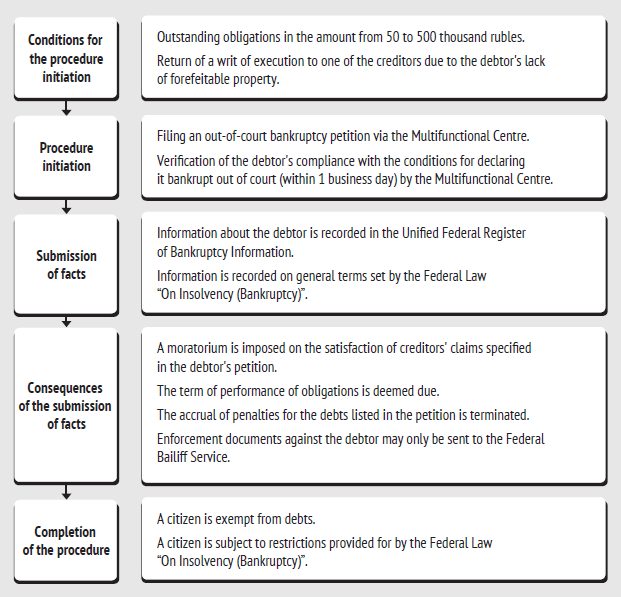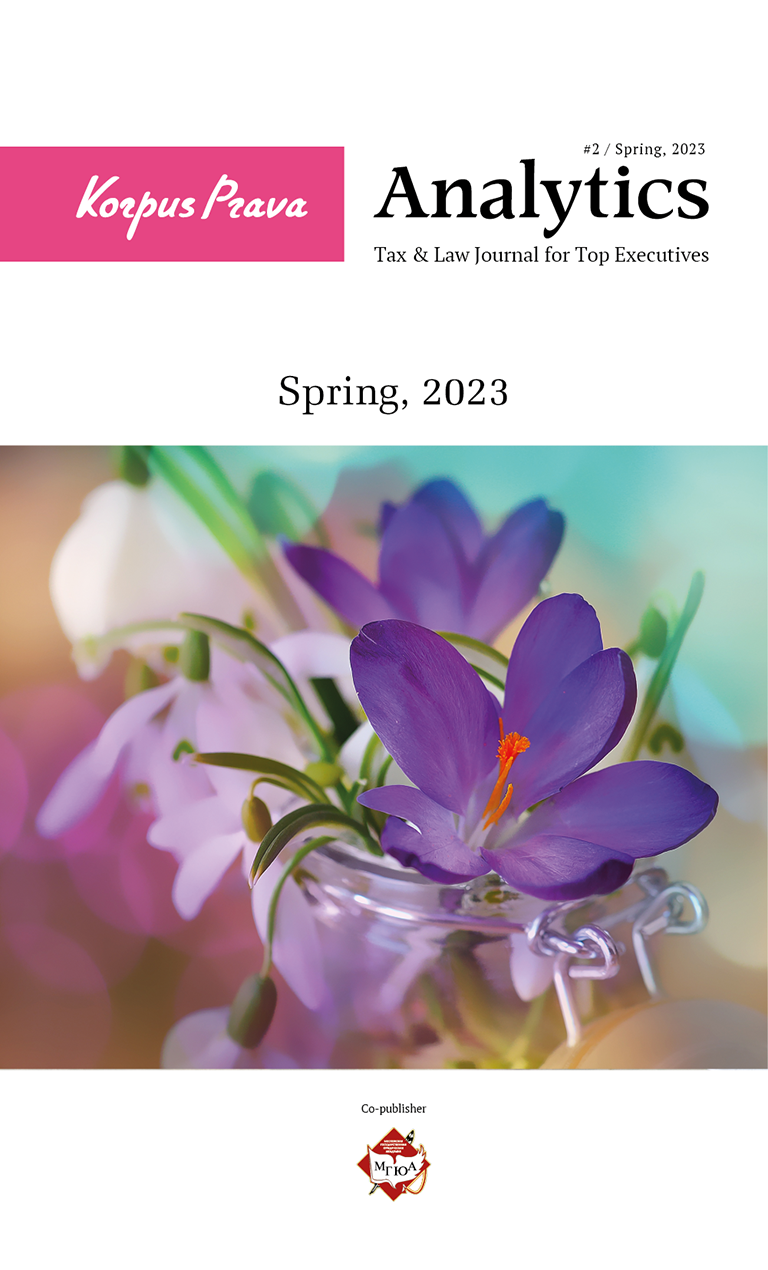Through court or not, that is the question
The bankruptcy procedure for individuals is a much rarer phenomenon than the bankruptcy of legal entities. However, occasionally, citizens, regardless of whether they are engaged in business activities, find themselves in the situation when they are unable to cope with their debts and are forced to follow such a lengthy procedure.
Starting from September 1, 2020, Federal Law No. 289-ФЗ “On Amendments to the Federal Law “On Insolvency (Bankruptcy)” and Certain Legislative Acts of the Russian Federation Regarding Out-of-Court Bankruptcy of Citizens” dated 31.07.2020 shall become effective. As the name suggests, this law offers the possibility for citizens to follow the bankruptcy procedure without filing a relevant petition to the arbitration court.
To that effect, a citizen shall meet a number of conditions introduced by the amended law, namely:
- The total amount of outstanding obligations (including obligations that are not yet due, alimony obligations and obligations under the suretyship agreement) is not less than 50 thousand and not more than 500 thousand rubles;
- Enforcement proceedings were terminated against him/her due to the absence of forfeitable property, after which no other enforcement proceedings were initiated.
If these conditions are met, the next step is to file a bankruptcy petition to the Multifunctional Centre. By filing a petition, a citizen confirms his/her compliance with the above conditions. Moreover, a citizen shall list all claims against him/her in such a petition that make up the number of outstanding obligations because of which the bankruptcy procedure is initiated.
It is crucially important for a debtor to list all possible claims, since in accordance with the general rule of the Federal Law “On Insolvency (Bankruptcy)” the deadline for fulfilling such claims will be deemed due, but most importantly, such claims will no longer incur a penalty, and after the successful completion of the bankruptcy procedure, a citizen will be released from the obligation to fulfill them. However, this rule does not apply to requirements that are not specified in the citizen’s petition. Therefore, if any claims are not specified in the petition both during the entire bankruptcy procedure and after it, they will continue to incur penalties, and a debtor will not be exempt from the obligation to fulfill them. Moreover, such creditors shall be entitled to apply to the arbitration court with a bankruptcy petition against a debtor on general terms during the entire out-of-court bankruptcy procedure.
It is also worth noticing that the out-of-court bankruptcy procedure is not a “cure-all” for debtors, since the new law limits types of obligations from which a citizen may be exempt upon its completion. Thus, a citizen shall not be released out of court from the obligation to fulfill the claims:
- For current payments;
- For compensation for personal injuries;
- For payment of wages and severance pay;
- Other claims that are inextricably linked to the creditor’s identity;
- For bringing a citizen to subsidiary responsibility as a controlling person;
- For compensation for losses caused to a legal entity with a citizen being its participant;
- For compensation for property damage caused intentionally or by gross negligence;
- For consequences application of invalidity of a suspicious transaction or a transaction that entails giving preference to one of the creditors over others.
The Ministry of Economic Development describes the innovation as “assistance to the least advantaged citizens who got into a difficult situation in freeing from debts and returning to a normal life”. Indeed, this procedure is a kind of step towards bona fide debtors who are objectively aware of their insolvency. It allows such debtors to both get free from their debt obligations relatively quickly and reduce the burden on arbitration courts.
At the same time, out-of-court bankruptcy leaves virtually no loopholes for mala fide debtors, i.e. there is no exemption from obligations if a debtor was brought to administrative or criminal liability for wrongful actions upon bankruptcy, deliberate or fictitious bankruptcy (under the bankruptcy proceedings), or if upon the occurrence or performance of obligations, on which the claims of the scheduled creditor are based, a debtor acted illegally (committed fraud, provided information known to be false when obtaining a loan, intentionally destroyed property, and committed other similar actions).
Upon completion of the out-of-court bankruptcy procedure, a citizen faces the same consequences as after a usual bankruptcy procedure:
- a citizen is unable to be registered as an individual entrepreneur for 5 years (if at the time of bankruptcy he was an individual entrepreneur);
- a citizen has no right to assume obligations under credit agreements or loan agreements without disclosing the fact of his/her bankruptcy for 5 years;
- a citizen has no right to hold administrative positions and generally participate in the management of a legal entity (for 3 years for ordinary legal entities; for 5 years for insurance companies, non-state pension funds, managing companies of investment funds, mutual funds or microfinance companies; for 10 years for credit organizations).
Debtors should keep in mind that if a citizen receives any property (as a gift, inheritance, etc.) sufficient for full or substantial discharge of the claims specified in the petition during the out-of-court bankruptcy procedure, he/she should notify the Multifunctional Centre thereon within 5 business days. In this case, the procedure will be terminated.
It is also important to mention that after the completion of the out-of-court bankruptcy procedure, a citizen may re-apply to the Multifunctional Centre with an out-of-court bankruptcy petition only after 10 years.
Therefore, there are the following stages of out-of-court bankruptcy:

Advantages of the procedure:
- free of charge nature (the cost of the court procedure is often huge for an insolvent debtor – starting from 100,000 rubles). Given that a debtor filing a bankruptcy petition is extremely limited in funds, this advantage is the most significant;
- simplicity (all that is required from a debtor is to execute a petition and list all the debts therein; the further procedure will be carried out without his/her participation, and there is no need to search for a financial manager);
- quick consideration (the new procedure is carried out within 6 months, while bankruptcy proceedings in the arbitration court may take years).
Disadvantages of the procedure:
- A debtor is subject to restrictions not only after the procedure, but also during it (particularly, during the period of out-of-court bankruptcy, he/she is prohibited to receive loans, credit facilities, issue guarantees and perform other security transactions);
- Conditions for admission to the procedure: in addition to the requirements for the amount of outstanding claims, an obstacle to the exemption from debts out of court for a debtor will be obligatory performance and completion of enforcement proceedings on the relevant grounds;
- Long term restrictions on filing another petition.
Other disadvantages are reduced to adverse bankruptcy consequences above, but they coincide with those upon the court bankruptcy and are irrelevant in the context of comparing the two procedures.
The out-of-court bankruptcy procedure is an innovation designed to simplify lives of citizens who are objectively unable to cope with debts and honestly admit it. Out-of-court bankruptcy is introduced both to reduce the burden on the judicial system, and to encourage the bona fide behavior of debtors in particular, and civil transactions in general. However, only time will show how effective and applicable this innovation is going to be in real terms.


